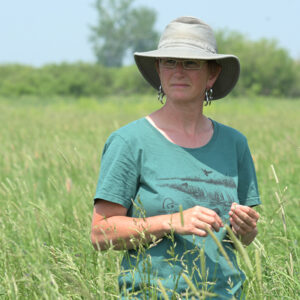News
October 24, 2023
Dormant seed forages now!
DUC has financial incentives and tips for success
Even with snow forecast, the time is right for farmers in southwest Manitoba to dormant seed forages and Ducks Unlimited Canada (DUC) is offering incentives and suggestions to improve success rates.
“The best time to dormant seed is when the soil temperature is five degrees Celsius or less,” says DUC forage specialist Charlotte Crawley. “You want the ground as cold as possible so the seed does not germinate until next spring. If temps are too warm, you run the risk of germination and winterkill, ruining your chances of a successful forage establishment.”

DUC forage specialist Charlotte Crawley
While not a common practice in western Canada, dormant seeding can provide farmers with several benefits over traditional spring seeding of forages.
Crawley says dormant seeding is a great solution for areas that are typically wet and difficult to access during the springtime. Fields are typically drier in the fall and less prone to surface crusting, which can prevent seedlings from breaking through the soil.
Marginal crop areas also respond well to dormant seeding because forage seedlings emerge as early as spring conditions allow, getting a jump on the weeds which tend to populate saline spots. DUC offers producers $200 per acre to seed forages in underperforming crop areas and can provide custom seed blends to maximize establishment success. Details at https://ag.ducks.ca/program/marginal-areas-mb/.
We recommend direct seeding into stubble and a seed drill is always the best option to ensure optimal seed-to-soil contact. Forages should be planted no deeper than one-half inch to three-quarters of an inch. If the soil is heavily worked, broadcast seed to prevent seeding too deep and follow up with a harrowing pass.
Crawley also suggests seeding at a higher-than-normal rate, from 15 lbs/acre to 20 lbs/acre.
“Seeding heavy is cheap insurance on a good establishment,” she says. “And resist the urge to only seed the bare patches. Make a pass or two where you have some stubble in the moderately saline areas to ensure plants establish. This will keep the salinity from spreading further into your crop and, over time, the forage will fill in the bare spots.”
When seeding into existing forage stands, DUC has seen success with sod seeding of legumes – if the proper equipment is used. A disc drill with coulters designed to cut through sod is the best option, especially in lighter soils where early spring seeding with adequate moisture cannot take place.
And don’t let snow change your plans. Crawley says you can successfully dormant seed with snow on the ground, provided you get seed-to-soil contact.
In addition to programs for dormant seeding, forage and marginal areas, DUC provides incentives and agronomic support for winter wheat, sod seeding, rangeland and pasture upgrades, and the preservation and restoration of wetlands and uplands.
As Manitoba’s oldest and largest conservation group, DUC has worked with over 3,000 Manitoba landowners since 1938 to conserve more than 711,000 acres (287,731 hectares). Call 204-285-9779 to find out about DUC programs and financial incentives or visit https://ag.ducks.ca/programs/manitoba/.

Don’t be afraid of seeding with snow on the ground.
